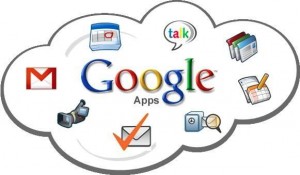Traditionally, some hallmarks of collaboration have included too many versions of documents to keep track of, some group members who are always out of the loop, and files that are simply too large to send as attachments to emails. But now these setbacks in group work can be classified as things of the past thanks to the collaboration capabilities of the cloud combined with those of Google Apps.
Google Apps, Google’s cloud computing service, has revolutionized the idea of collaboration. Because of Google Apps’ mobile access, communication features, and sharing capabilities, groups of people can now access and edit the exact same information simultaneously from anywhere.

<credit>
With Google Apps tools like Gmail, Google Calendar, Google Docs, Google Sites, and Google Groups, the collaboration possibilities are endless. Gmail provides users with a simple way to communicate with others online and includes IM and video chat for more instant connections. While the other tools available in the Google Apps suite have very different purposes, they all work to promote collaboration with others by allowing users to share information.
Though Google Calendar functions like many other calendar systems, allowing users to create events on multiple calendars and program reminders, it goes beyond these other systems due to its sharing capabilities. With Google Calendar, users can share specific calendars with others so they can easily schedule meetings based on the user’s availability.
Google Docs allows users to create files such as word documents, presentations, and spreadsheets, and store them in their Google Apps account. But Google Docs goes far beyond any other document-creating program. With the sharing function of Google Apps, owners of specific Google Docs can share these files with as many or as few people as desired. Once a file is shared, anyone who has access to edit the document can do so from any location. And multiple people can edit the same document simultaneously from anywhere, meaning that groups no longer need to be in the same place to work together. Users can also make comments for others to resolve, and can track the revision history of the document to see who made what changes, and when.
Using Google Sites is a great way to keep all group members on the same page – literally. With Google Sites, users can easily create a website or intranet for a specific group of people. On this site, users can upload everything from files to tasks, responsibilities, and deadlines. Google Sites is key to ensuring that all group members stay up-to-date, as it puts all the necessary information in a central and organized location.
While Google Sites helps keep group members on task, Google Groups is perfect for communicating with everyone as a whole. Users can send emails to and share documents and calendars with the group as a whole, rather than having to add each person. Google Groups also archives discussions, to make finding past conversations fast and easy. Additionally, if a message is sent to the group, users can respond on behalf of the entire group.
These sharing and communication tools only scratch the surface of the collaboration capabilities that come standard with every Google Apps platform.
This blog post is brought to you by Cloud Sherpas. Cloud Sherpas is a leading Google Apps cloud service provider. As a Google Apps Authorized Reseller and Google Enterprise partner, we have migrated over one million users across all major industries from legacy, on-premise messaging systems to Google Apps, helping organizations adopt cloud computing to innovate and dramatically reduce their IT expenses. Get to know our company by checking out our Facebook page at www.facebook.com/cloudsherpas.
